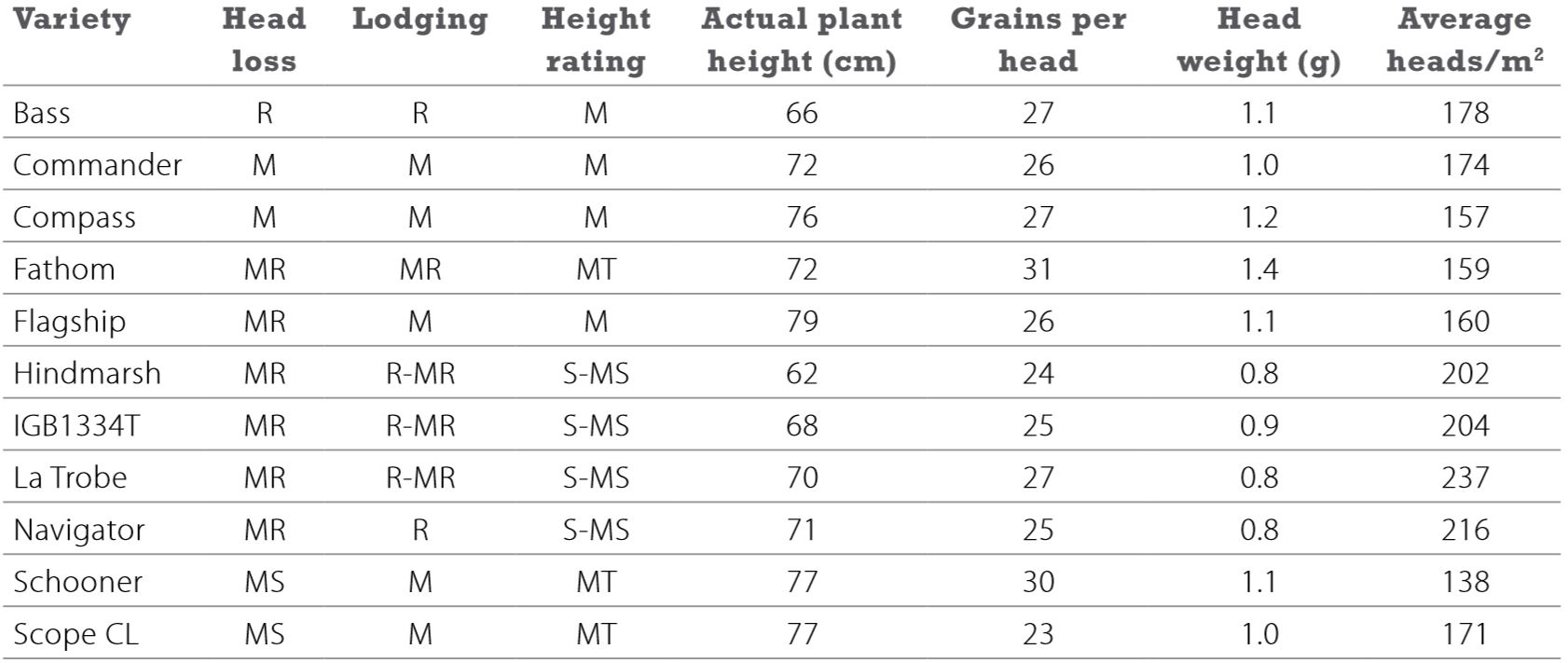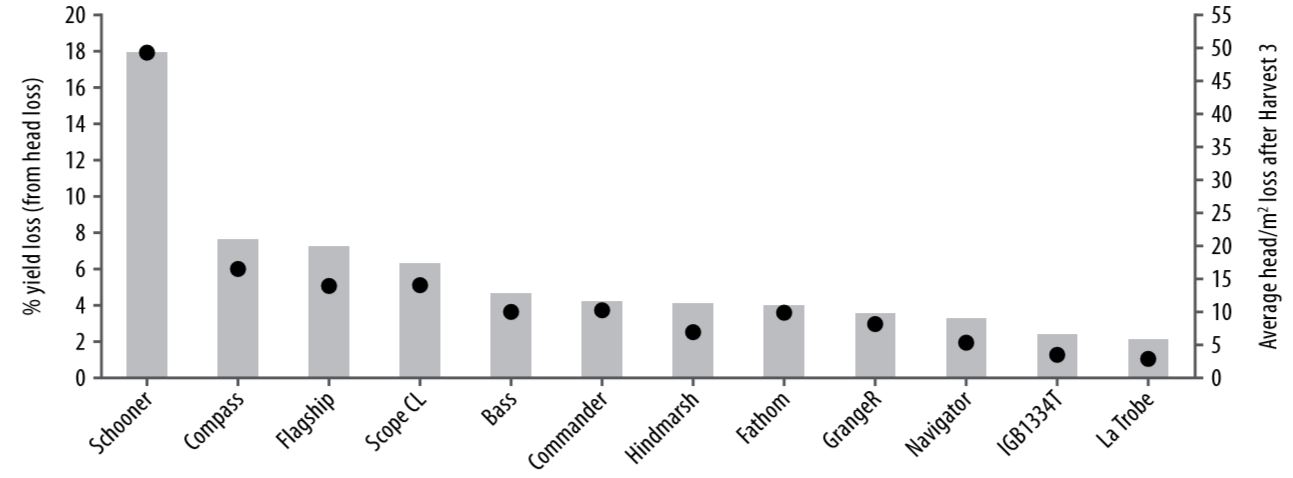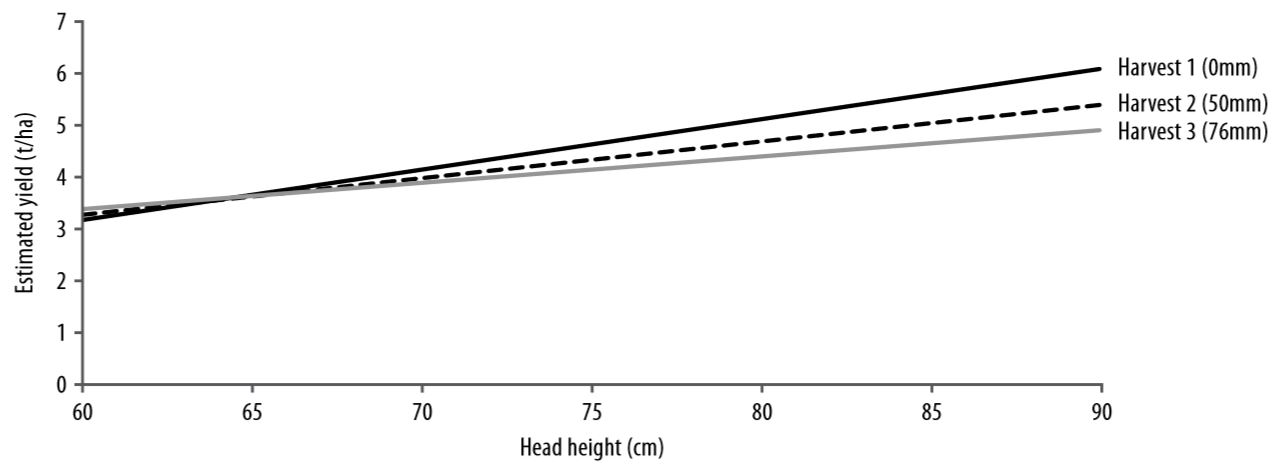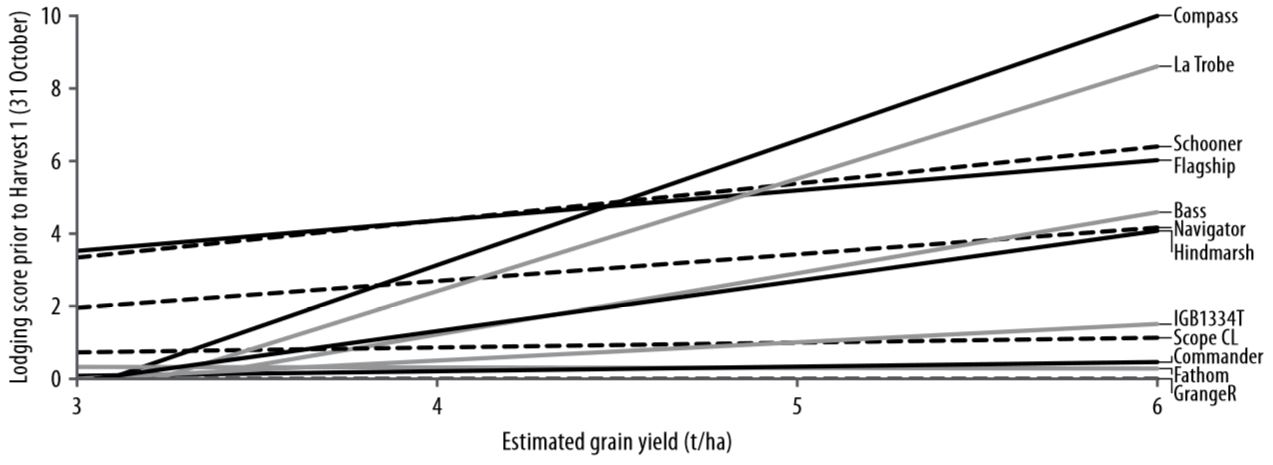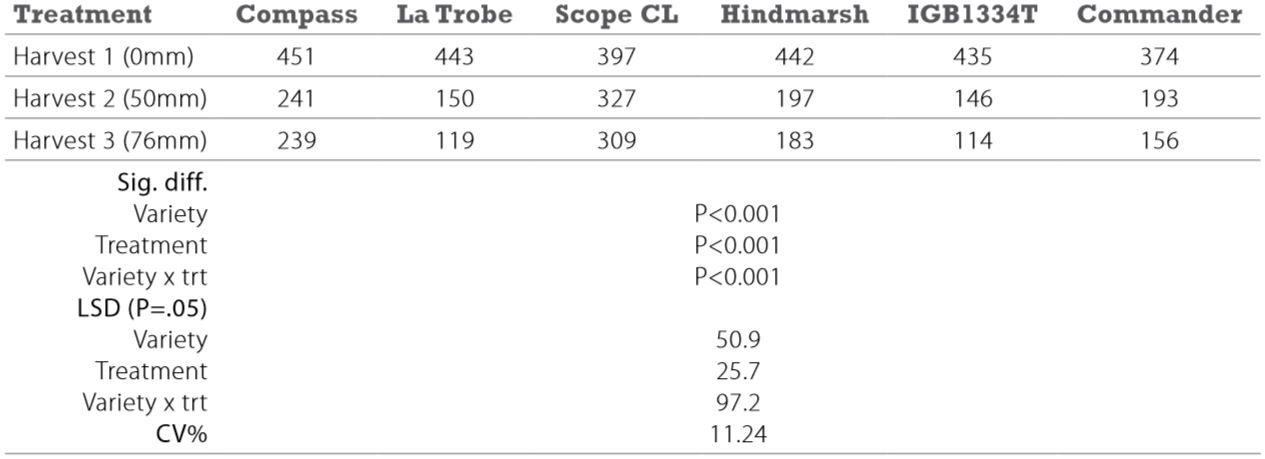Take home messages
- Compass and La Trobe have the greatest likelihood of severe lodging as yield environment increases; Fathom, GrangeR and Commander are least likely.
- The taller the crop, the more likely yield loss will occur with increasing rainfall; taller varieties (Schooner, Compass, Flagship and Scope CL) are the most susceptible to head loss.
- Grain quality and the viability of the seed (low falling numbers) is severely reduced in barley with greater exposure to wet weather.
- In lower yielding environments, choose a variety based on its yield performance, rather than its resistance to the effects of delayed harvest.
Background
Extreme weather events at harvest can cause significant disruptions to the program, preventing all crops from being harvested within their optimum window. The main concerns for growers are yield losses due to lodging and head loss, grain quality damage (low test weight, higher retention, grain discolouration through fungi and staining) and shot or sprouted grain. Lodging has the potential to affect yields and cause growers significant frustration at harvest.
Lodging can occur in two forms:
- root lodging, in which the anchorage system of a plant fails
- stem lodging, when the lower internodes begin to buckle.
Higher yielding crops (with high biomass and height) are more susceptible, particularly when conditions are favourable. Specific varieties also differ in their susceptibility to lodging, head loss and sprouting. The amount, timing and duration of rainfall events and related humidity and temperatures can influence sprouting. When this occurs in the grain, it results in an increase in alpha-amylase, an enzyme that breaks down the starch content. Grain that has sprouted is not suitable for malting or sowing the following year because of loss of seed viability, reduced capacity for long storage time and a decline in feed value.
As germination in the grain is often not visible, the level of sprouting is measured by the ‘falling numbers’ test. A value of 300 seconds is the minimum standard for malt barley.
Aim
To determine the impact of delaying harvest on yield and grain quality and to create management packages for varieties, as a guide for farmers.
Trial details
Location: Wemen
Soil type: Sand
Annual rainfall: 238mm (including 37mm of irrigation in season)
GSR (Apr-Oct): 179mm (including 37mm of irrigation in season)
Crop type: Bass, Commander, Compass, Fathom, Flagship, GrangeR, Hindmarsh, La Trobe, IGB1334T, Navigator, Scope CL and Schooner barley
Sowing date: 28 April
Seeding equipment: Knife points, press wheels, 30cm row spacing
Target plant density: 130 plants/m²
Harvest dates: 2 November, 23 November, 9 December
Trial inputs
Fertiliser: Granulock Supreme Z + Impact @ 50kg/ha at sowing plus urea @ 80kg/ha and SOA @ 50kg/ha at mid tillering.
Weeds, pests and diseases were controlled to best management practice.
Method
A replicated field trial using a split plot design was sown into a fallow paddock with 152kg/ha of starting soil nitrogen (N). The trial was irrigated twice during the season, using overhead sprinklers (a total of 37mm). Barley varieties were chosen based on lodging and head loss resistance (Table 1).
Table 1: Barley variety head loss and lodging ratings, actual plant height measure from trial, average grains per head and head weight.
Head loss and lodging rating- R = resistant, MR = moderately resistant, MS = moderately susceptible, S = susceptible. Height rating- T = tall, MT = moderately tall, M = medium, MS = moderately short, S = short
The trial included three harvest timings and three different water applications prior to each.
Harvest 1: control: received no irrigation or rainfall. This treatment was harvested on time when crop had just reached physical maturity.
Harvest 2: a 21 day delay with 50mm of irrigation and rainfall between harvest 1 and the day of harvest 2.
Harvest 3: a 37 day delay after harvest 1 with 76mm of irrigation and rainfall prior to harvest 3.
The crop was exposed to moisture and humidity for a sustained period of time and irrigation was slow and soaking (3.5 hours to apply 20mm). The irrigation was targeted when actual rainfall was forecast and when conditions were humid with lower temperatures and low wind speed (to maintain consistency in irrigation) to better simulate the ‘rainfall’ effects of the irrigation.
Assessments during the season included head loss counts (prior to and after harvest), counts of grains per head/variety, head height (measuring height of plant from base to tip of head), amount of heads per plant/variety and lodging scores. Lodging was visually measured on a scale of 0-10, (0 = no lodging, 10 = severely lodged).
Falling numbers were tested on only six of the varieties (selected if currently a malt/food variety or undergoing accreditation). Samples were tested by DEDJTR Horsham (Agriculture Victoria) using a Perten Falling Number 1700 and 1800 units. Grain was also analysed for protein, test weight, retention and screenings using a CropScan 3000B grain analyser.
The site was EM38-mapped to account for any variability in soil type throughout the trial. Individual plot data points were then used as a co-variate against yield, grain quality and assessment data taken, to help overcome any potential issues.
Results and interpretation
Environmental conditions
In the week leading up to, and during, the first irrigation (before Harvest 2), thunderstorms occurred (Figure 1) and 6.4mm of rain fell. During this period, when conditions were still favourable, the trial was irrigated with 20.6mm and the following day with another 19.6mm. From 30 October to 8 December humidity was above 70 per cent for 92 hours (Figure 2) and average temperatures and maximum wind speeds were relatively low also. This combination of humid conditions and rewetting of the grain, potentially created an environment favourable for sprouting to occur.
Prior to Harvest 3, humidity was much lower, with fewer hours of humidity above 70 per cent (Figure 2). Maximum temperatures and wind speed spiked before and during the application of the final 26mm of irrigation. These conditions were conducive to lodging and head loss.
Figure 1. Average daily temperature (°C) and maximum daily wind speed (km/hr) from Lower Murray Water Wemen weather station and daily rainfall (mm) measured by BCG rainfall tinytag from October 28 to 9 December.
Figure 2. Number of hours humidity was above 70 per cent from October 28 to 9 December.
The effects of delayed harvest and rainfall on yield, head loss and lodging
Due to the in-season irrigation, the yields in this trial (average 3.7t/ha) were considerably higher than the yields achieved in the Mallee in 2015. Nitrogen (in combination with soil N) and water (irrigation) was applied to satisfy crop demand and ensure the crops were sufficiently heavy to determine the effects of a delayed harvest on specific varieties.
The soil type was slightly variable across the trial site, making it more challenging to analyse actual varietal differences in yield loss (t/ha) between harvest timings. As a result, relationships between head loss, plant height and lodging were analysed.
The tallest varieties (Schooner, Compass, Flagship and Scope CL) were most susceptible to head loss, when averaged over all harvest times (data not shown). When harvest was delayed by 37 days (Figure 3), Schooner incurred an 18 per cent yield loss, Compass six per cent and Flagship and Scope CL five per cent.
Scope CL, Flagship and Schooner, varieties known to be prone to head loss, were included in the trial to determine the fit of new varieties in the spectrum. The losses in Schooner were visually observable prior to the third harvest. Plant stems were still standing upright but the heads had fallen off.
As expected, the longer harvest was delayed, the greater the head loss. The 0mm treatment on average lost 1.8 heads/m2 (all variety data) compared with 4.6 heads/m2 in the 40mm treatment and 12 heads/m2 in the 80mm treatment.
The 2013 and 2014 results also confirmed that Scope CL is very prone to head loss. Findings from 2014 showed that when subjected to rainfall and windy conditions Compass and Schooner are also susceptible. Fathom, GrangeR and Commander exhibited good head retention and standability over the last three years of data.
Figure 3. Head loss (heads/m2) of varieties when harvest is extremely delayed (Harvest 3) and total percentage of yield loss associated with this.
Plant height was measured to determine whether there was a relationship between height and yield loss. Figure 4 shows the relationship between head height and yield for the different harvest timings. Where the crop was taller in the trial, yields were greater (which reflects soil variability).
Plants that were shorter/lower yielding (60-70cm; around 3t/ha), suffered no yield penalty in the presence of rain/irrigation. In a taller/higher yielding crop however, (>70cm-90cm), when 50mm76mm of water was applied, reductions in yield occurred.
Figure 4. The interaction between mean yield (t/ha) and plant height.
Lodging was evident during the season, with plants limited neither by N nor moisture. Consequently, crops were bulkier and taller with a higher number of tillers. Stem and root lodging were also evident at harvest time, with root lodging most apparant in the high yielding areas. By the time the third harvest took place, a number of the the plots were quite lodged and rotted to the point of being flat on the ground.
The longer harvest was delayed, the more visually evident was the lodging in the high yielding plots. Lodging scores taken throughout the trial (prior to Harvest 1) showed differences between varieties (P=0.033).
A regression model was created to estimate the severity of lodging in the varieties as the yield potential increased (Figure 5). It showed that Compass in particular, and La Trobe, are most likely to severely lodge as yield potential increases to over 5t/ha. Despite lodging severity increasing in La Trobe, its head retention and susceptibility to yield loss were low, in contrast to those of Compass (Figure 3).
GrangeR, Fathom and Commander were least likely to lodge under very high yielding conditions. Compass and La Trobe were very high yielding and it stands to reason that these heavier crops would lodge. This occurs because, with more bulk, stem thickness and strength are reduced and the crop becomes more fragile and less able to withstand very windy conditions (as experienced in this trial). Rainfall will also add weight and pressure on the stems, reducing the standability of the crop. This lodging data is more applicable to growers in high yielding environments and under irrigation.
Figure 5. Lodging score (0-10) taken prior to Harvest 1 (31 October) for varieties showing the relationship between estimated increasing yields and lodging.
The effect of delaying harvest on grain quality
As harvest was delayed, test weight (grain weight) decreased. With 50mm of rainfall/irrigation (Harvest 2), the average grain weight fell by 1.2kg/hl and a further 1.7kg/hl with an additional 26mm (Harvest 3). There was no interaction in test weight, protein and screenings between varieties and treatments.
Conditions that favour sprouting are also conducive to fungal growth. By the third harvest timing, it was evident that field fungi were present in the grain and dark tipping was visible on a small percentage of grains. This is due to the exposure to moisture and humidity throughout this period. Coverage of greater than 10 per cent of the grain surface is considered to be defective: it can affect germination and consequently grain is downgraded at receival sites. The fungi coverage on the barley, however, did not reach this level and did not appear to be variety specific.
The effect of rainfall on the soundness of the grain
Varieties responded differently to harvest timings in terms of falling numbers. In the absence of rain, most varieties had similar falling numbers although, after the irrigation was applied (Harvest 2 and 3), La Trobe, IGB1334T, Commander and Hindmarsh had significantly lower falling numbers than Scope CL (at any harvest) and varieties at Harvest 1.
Conditions created by the application of 50 mm rainfall (Harvest 2) were conducive to sprouting. In this situation, barley is shown to have a relatively poor tolerance to rainfall events of 50mm or greater.
Severely lodged plots were also more likely to have lower falling numbers. This is because the plots that were very lodged may have retained moisture in the canopy for longer providing a humid environment suitable for sprouting.
Table 2. Falling numbers (seconds) for the barley varieties at Harvest 1 (0mm), Harvest 2 (50mm) and Harvest 3 (76mm).
Commercial practice
Rainfall at harvest can be a farmer’s worst nightmare (aside from drought), especially when yields are high. The effects of a delayed harvest can be substantially greater in a high yielding environment; variety selection based on a given environment is important.
Lessons from this trial
- Compass and La Trobe have the greatest potential to lodge in high yielding environments (>5t/ha).
- Taller varieties Schooner, Compass, Scope CL and Flagship are more prone to head loss in favourable conditions.
- The taller the crop, the more likely yield loss will occur with increasing rainfall.
- In a wet, delayed harvest, falling numbers decline significantly with increasing rainfall. In this trial, Commander, IGB1334T, La Trobe and Hindmarsh were the most affected in the presence of rainfall in terms of a decline in falling numbers. Scope CL was the most tolerant variety.
- In a high yielding environment or under irrigation, varieties such as La Trobe, Compass or Scope CL are inadvisable, as significant losses could be incurred from head loss and lodging.
- In low yielding environments, selection of a high-performing variety is advisable, rather than one chosen on the basis of its resistance to the dangers of delayed harvest (if yield will be compromised).
Managing risk at harvest
- Yield is still king. Select a variety based on its performance. However, in high yield potential areas and on irrigation, consider choosing a variety with good resistance to delayed harvest to minimise losses.
- Spread risk by choosing varieties with different maturities and ratings for head loss and lodging.
- Prioritise harvesting susceptible barley varieties (in terms of head loss, lodging and sprouting) such as Compass, La Trobe, Scope CL and IGB1334T, Commander, IGB1334T (sprouting).
- Keep the crop clean of foliar and stubble-borne diseases to improve the standability of barley.
- Be careful of retaining seed that has been subjected to wet weather at harvest. It is essential to perform germination tests prior to sowing to determine whether seed is viable. Seed with a germination of less than 70 per cent should be rejected. Seed that is greater than 90 per cent is sound.
- Weather damaged seed deteriorates at a much faster rate than sound seed. Keep this in mind when storing grain and selling after harvest.
- Protect the heads. The number of heads directly influences yield. In a high yielding environment, and when the season is favourable, consider using plant growth regulants (PGRs) which may help prevent lodging and increasing stem thickness.
- In favourable seasons consider hiring in a contractor to get the crop off more quickly (approximately an additional $25/ha) or windrowing crops ($25-35/ha) to avoid a delayed harvest.
On-farm profitability
Selecting a variety based on yield performance rather than solely on head retention and lodging ratings is important. If cropping under irrigation or in a high yielding environment, selecting a variety for its resistance to head loss and lodging will be beneficial. Otherwise the losses associated with a delayed harvest in lower rainfall areas in most years may not be sufficiently substantial to influence yield and quality. Be aware of varieties susceptible to sprouting, lodging and head loss and manage them accordingly at harvest if unfavourable weather is imminent. Timeliness and prioritisation, PGRs (if economical), arranging a contractor or windrowing are all strategies that can be employed to minimise losses from delayed harvest.
References
Barley trading standards, Graintrade, accessed 6/1/2016
Mayfield A et.al, 2015, GRDC Retaining seed FactSheet, ‘Saving weather damaged grain for seed’
Phillips N, Weather damaged cereal seed, Prime facts, accessed 6/1/2016
Acknowledgements
This trial was conducted as part of the GRDC-funded ‘Barley agronomy for the southern region initiative’ (DAN00173). The project collaborators include NSW DPI, SARDI, BCG and SFS.
